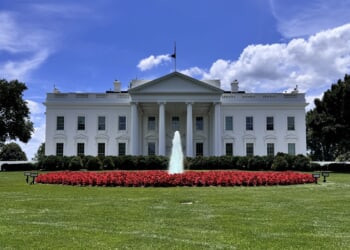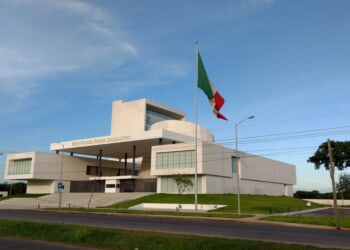The most recent “Voices of Gen Z” study, a joint project of Gallup and the Walton Family Foundation, had both encouraging and concerning news.
The encouraging news was this: Members of Gen Z (those born from 1997 to 2012) are overwhelmingly optimistic about the future. The concerning news: They worry a lot, including about their mental health.
For those of us in the educational field, the even bigger takeaway came later: The Gen Z students “most engaged in school” were found to be “more than four times as likely than the least-engaged students to strongly agree they have a great future … and are 10 times more likely to strongly agree they feel prepared for the future.” And, as the Walton Family Foundation explained, students reported feeling most engaged when “their teacher made the topic interesting or exciting.”
Unlike the vast majority of our ancestors, today’s generations have reason to be optimistic.
For many students, history is one of the classes they would rather sleep through. Who wants to memorize distant names and dates? What they don’t understand is that learning about the past (in an engaging way, of course) can tell them a lot about the present and help them, as future voters and leaders, create the future.
Consider the all-American idea that every generation should be blessed with a future better than their parents’ generation. For most of history this hasn’t been the case.
Though the past 100 years may seem like a roller-coaster — the Roaring 20s, the stock market crash of 1929, the Depression, WWII and the Holocaust, the fabulous ’50s, the turbulent ’60s, the swinging ’70s, the birth of the computer age, globalization, AI, Elon Musk, and Donald Trump and his on-again, off-again tariff wars — what’s really striking is when you compare this period with previous centuries.
For most of human history there was no roller-coaster, just misery. Life was “poor, nasty, brutish, and short,” as the seventeenth century English philosopher Thomas Hobbes wrote.
Sure, there were many historic occurrences: plagues and famines, conquests and wars, the rise of Christianity, the Magna Carta, the birth of America. But what really defined most of the period from the earliest cave dwellers and food scavengers until the mid-to-late 1700s was hunger, disease, and the daily struggle to survive.
Even at the time of America’s founding 250 years ago, life for most was a challenge. Abigail Carroll in her 2013 book, “Three Squares: The Invention of the American Meal,” quotes a 1744 traveler describing a family meal, served “in a dirty, deep, wooden dish which they evacuated with their hands, cramming down skins, scales, and all. They used neither knife, fork, spoon, plate, or napkin because, I suppose, they had none to use.”
Then something changed.
‘The Great Fact’ and Our Future
Economist and historian Diedre McCloskey, senior fellow and holder of the Isaiah Berlin Chair in Liberal Thought at the Cato Institute, describes what happened as “The Great Fact”: about the same time as the United States’ founding, people in Western Europe started to recognize the value of merchants, tradesmen, and financers — what McCloskey, in a brilliant book, refers to as “Bourgeois Dignity.”
That, in turn, helped fuel the Industrial Revolution, which took off in the late 1700s. The rest, as they say, is history.
If you lay a hockey stick on the ground, blade up, you can see the trajectory of economic history. The shaft, the long part of the stick, is everything that came before the great fact. While there were occasional advances, in the long arc of history the occasional advances amounted to relatively little. The blade, pointing toward the sky, is everything since.
McCloskey estimated that people living in today’s advanced societies easily have “sixteen times more food and clothing and housing and education” than their forebears in the 18th or 19th centuries — and in some places, such as South Korea, until the mid-20th century.
“And if such novelties as jet travel and vitamin pills and instant messaging are accounted at their proper value,” McCloskey suggests, “the factor of material improvement climbs even higher … to 18, or 30, or far beyond.”
Members of Gen Z should realize how fortunate they are to have been born when they were, with commerce, entrepreneurship, innovation, and trade among the cornerstones of thriving societies — creating futures that are better for each generation.
Unlike the vast majority of our ancestors, today’s generations have reason to be optimistic.
Sure, there will be ups and downs. That’s the headline news. The more important news is that the blade still points skyward.
READ MORE:
American Prosperity Depends on Free Trade
Will Republicans Own the Brewing Budget Calamity?
Richard Lorenc is president and CEO of Certell, Inc., a national education-technology nonprofit that provides schools and teachers with free digital curricula in U.S. government, U.S. history, world history and economics.


![NYC Tourist Helicopter Falls into Hudson River, Siemens Executive and Family Among Those Killed [WATCH]](https://www.right2024.com/wp-content/uploads/2025/04/NYC-Tourist-Helicopter-Falls-into-Hudson-River-Siemens-Executive-and-350x250.jpg)






![Green Day’s Cringe Trump Diss Ends in Fire and Evacuation [WATCH]](https://www.right2024.com/wp-content/uploads/2025/04/Green-Days-Cringe-Trump-Diss-Ends-in-Fire-and-Evacuation-350x250.jpg)
![Red Sox Fan Makes the ‘Catch of the Day’ with Unconventional ‘Glove’ [WATCH]](https://www.right2024.com/wp-content/uploads/2025/04/Red-Sox-Fan-Makes-the-‘Catch-of-the-Day-with-350x250.jpg)
![Bikini Clad Spring Breakers Prove Our Education System is Failing Students [WATCH]](https://www.right2024.com/wp-content/uploads/2025/03/Bikini-Clad-Spring-Breakers-Prove-Our-Education-System-is-Failing-350x250.jpg)





